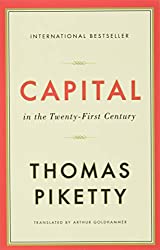
Rating: 8.0/10.
Summary
The magnum opus of French economist Thomas Piketty, and quite a long one (~750 pages). Published in 2013, it uses historical data to study the distribution of wealth and income from 1700 until now, and models long-term trends in capital distribution and inequality. The central message is reminiscent of Marx’s Communist Manifesto: that if the trends continue into the future, inequality will continue to worsen, and eventually reach a point that’s incompatible with society.
Two “fundamental laws of capitalism” are useful for understanding the long-term evolution of capital in a society. First, the capital / income ratio (beta) is a measure of how much capital there is (in years of average labor); let alpha be the ratio of income that goes to owners of capital (and 1-alpha goes to labor); the equation is alpha = r * beta, where r is the rate of return of capital. Second, beta = s / g where s is the savings rate and g is growth. When growth is low, in particular r > g, eventually beta will be very high, meaning more and more of income will go to owners of capital instead of labor.
Marx predicted in the 1850s that capitalism would soon collapse on itself, but that didn’t happen because of growth. In high-growth societies, including the 19th and 20th centuries, inequality is not too bad because labor is relatively more valuable than returns from capital, but Piketty argues that high growth cannot continue forever, so we must eventually return to a state of low growth that’s been dominant for most of human history. When that happens, the fundamental laws of capitalism will force a return to the 19th century society of Austen and Balzac novels, where inheritance is the only ticket to wealth, more than any possible career.
The nature of capital has changed drastically over the last 300 years. In the 18th century, agricultural farmland made up most of capital, but farmland is relatively unimportant now. Foreign ownership was high during colonial times, but is now about net neutral. Interestingly, inflation did not exist until WW1, so literature before that period could refer to prices and not become quickly obsolete.
Inequality was extremely high during the 18th and 19th centuries, reaching its peak just before WW1. The two world wars and the intervening period of depression destroyed a lot of capital and inequality was greatly reduced; after WW2, inequality has steadily risen and is almost as high as previously. Wealth inequality is always greater than income inequality. The author illustrates the trends by graphing how the proportion of income / wealth of the top 10% / 1% / 0.1% changed for Britain / French / USA.
The structure of the new form of inequality is different from before, though. Prior to WW1, extreme wealth inequality came in form of people who owned a lot of capital (property and government bonds) and lived off the rent earned from that capital, without having to work. Nowadays, inequality comes from high incomes paid to professionals and “supermanagers”; income from capital is less relevant since it is only when you get to the top 0.1% in western countries that income from capital exceeds income from labor. The increased returns from labor is partly from technology and education improving efficiency of labor, but also from top executives having the ability to pay themselves more.
The book then describes what life was like in the 19th century society of Austen and Balzac novels. In these novels, you needed to make about 30x the average income to be considered comfortable. The top lawyers, even after several decades of climbing to the top of the hierarchy, only made 10x the average income, so Balzac’s character is persuaded to marry into an inherited fortune instead of pursuing a career. Our society could turn into this in a few decades if capital continues to accumulate and growth slows down.
In the last section, the author discusses how to combat inequality. We should adopt a more progressive taxation system, with marginal tax rates above 80% in the highest bracket (it’s currently 40-50%). Furthermore, since the most wealthy people get their income not from labor but from capital, Piketty proposes a global wealth tax, where about 4-5% of total wealth every year is taxed. This would require all countries to adopt this policy so you can’t just take your money somewhere else, and would also require all governments and banks to share information so they can determine how much wealth everyone owns. To me, this seems extremely naive and almost unbelievable as a serious proposal from a top economist. The closest we can get is probably a system like China’s, where banks are state-owned, and there are strict controls limiting how much capital can leave the country.
Limitations
The ideas are insightful, although the book felt more drawn-out than it needed to be. Many analyses were repeated for Britain / France / USA, and again for the top 10% / 1% / 0.1%, etc. Also, a lot of pages were devoted to describing the data sources and their limitations and how this may have affected the results. Surely these details are important for verifying the claims, but it’s not so interesting to read, so he could’ve probably cut the book by 2-3x if they were put in an appendix. Another weakness is the book focuses on a few western countries (claiming it’s because the data is plentiful) and leaves out developing countries (including China). Now, the rivalry is between US and China, and the economy of France is far less relevant now than 100 years ago.
The book quickly generated a large amount of academic debate. One line of criticism from libertarians is that Piketty assumes inequality in bad without justifying why from any ethical framework, they argue that increasing overall wealth should be the focus. Some economists attacked the data and methodology and the theory of why r > g should lead to inequality. The wealth tax proposed was criticized as unrealistic given the current state of corporate tax avoidance, and shifts attention away from more practical policies.



